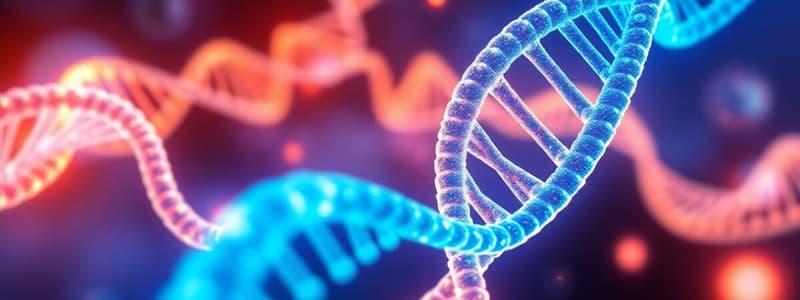Podcast
Questions and Answers
Which of the following statements correctly describes the structure of DNA?
Which of the following statements correctly describes the structure of DNA?
- Single-stranded with a straight shape, composed of ribose sugar, and nitrogenous bases A, G, U, and C
- Double-stranded with a straight shape, composed of deoxyribose sugar, and nitrogenous bases A, G, T, and C
- Single-stranded with a helical shape, composed of ribose sugar, and nitrogenous bases A, G, U, and C
- Double-stranded with a helical shape, composed of deoxyribose sugar, and nitrogenous bases A, G, T, and C (correct)
During DNA replication, what is the role of the enzyme that breaks hydrogen bonds between complementary bases?
During DNA replication, what is the role of the enzyme that breaks hydrogen bonds between complementary bases?
- To create a template for RNA transcription
- To create new DNA strands from free nucleotides
- To separate the two strands of the DNA molecule (correct)
- To join the newly synthesized DNA strands to the original strands
The process of DNA replication is described as semi-conservative. What does this mean?
The process of DNA replication is described as semi-conservative. What does this mean?
- Both new DNA molecules are entirely composed of newly synthesized strands.
- Each new DNA molecule contains one original strand and one newly synthesized strand. (correct)
- The process is only partially complete, resulting in a combination of original and new strands.
- Both new DNA molecules are entirely composed of original strands.
What is the correct order of information flow in the central dogma of molecular biology?
What is the correct order of information flow in the central dogma of molecular biology?
Which of the following is a characteristic of RNA that differs from DNA?
Which of the following is a characteristic of RNA that differs from DNA?
Flashcards
Structure of DNA
Structure of DNA
DNA has a double-stranded structure.
Function of RNA
Function of RNA
RNA is single-stranded and helps in protein synthesis.
DNA Replication
DNA Replication
The process of creating two identical DNA molecules from one.
Central Dogma of Molecular Biology
Central Dogma of Molecular Biology
Signup and view all the flashcards
Transcription
Transcription
Signup and view all the flashcards
Study Notes
DNA vs RNA
- DNA structure: Double stranded
- DNA sugar: Deoxyribose
- DNA bases: A, G, T, C
- DNA shape: Helical
- RNA structure: Single stranded
- RNA sugar: Ribose
- RNA bases: A, G, U, C
- RNA shape: Straight
Central Dogma of Molecular Biology
- DNA carries genetic material, determining traits
- Flow of genetic information explained by the central dogma
- Two-step process: Transcription and translation
- Transcription: DNA copied to RNA
- Translation: RNA used to produce proteins
- Information flows from DNA to RNA to protein
DNA Replication
- DNA replication: Creating identical DNA copies
- Occurs during interphase of the cell cycle
- Double-stranded DNA unwinds
- Enzyme breaks hydrogen bonds between bases
- Free nucleotides align with exposed DNA (complementary base pairing)
- Forms two new DNA molecules containing one original strand and one new strand (semi-conservative)
Studying That Suits You
Use AI to generate personalized quizzes and flashcards to suit your learning preferences.




